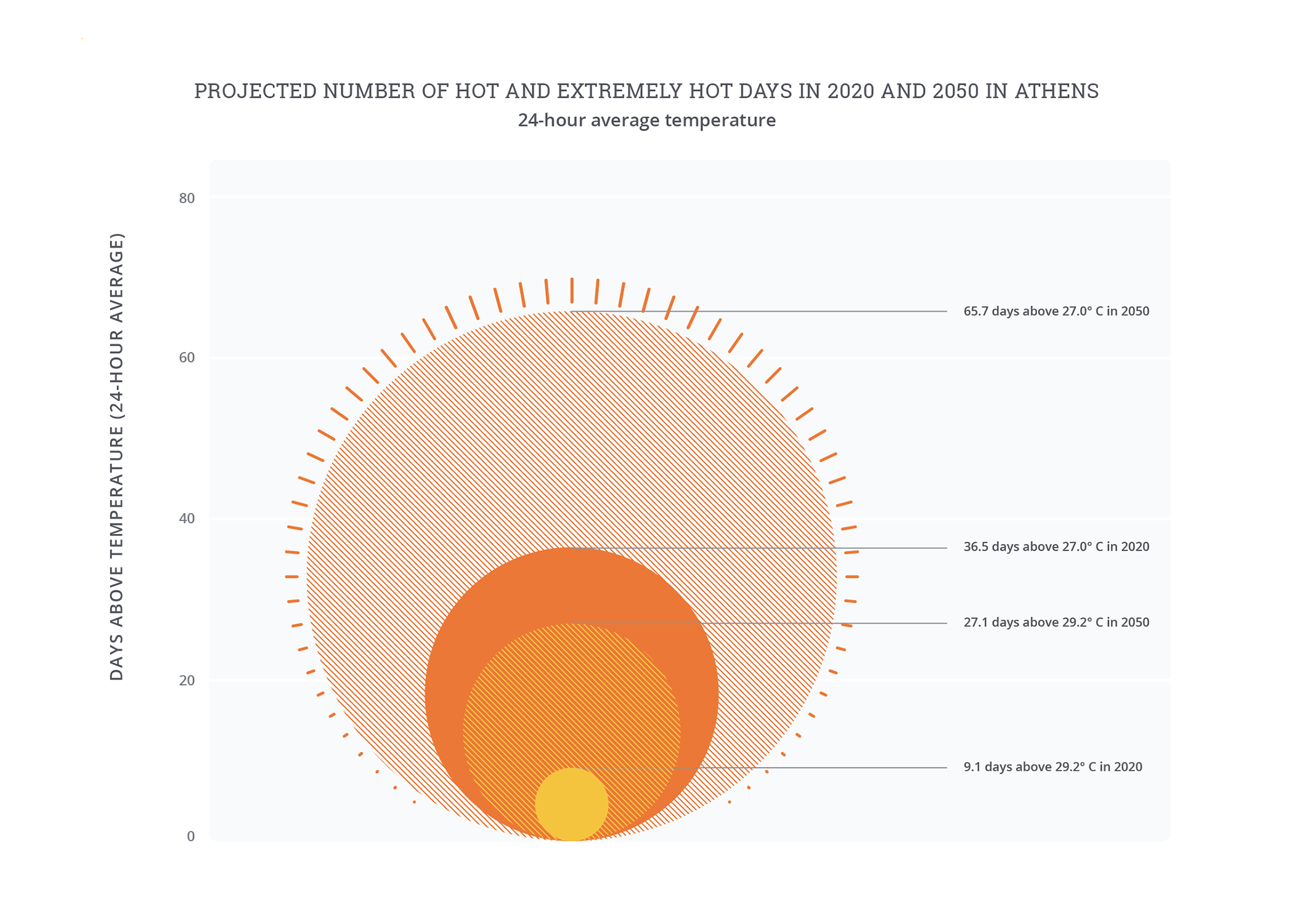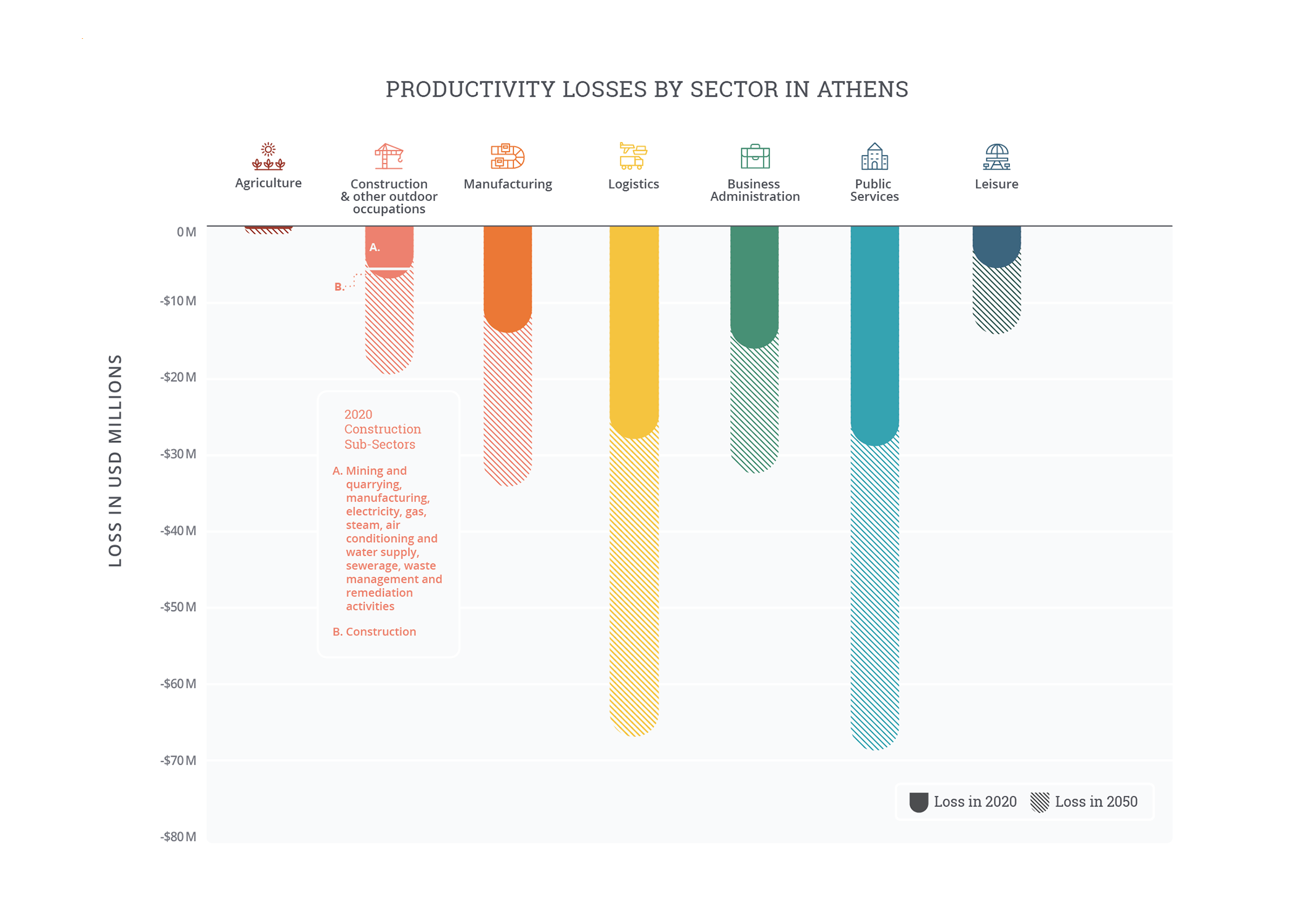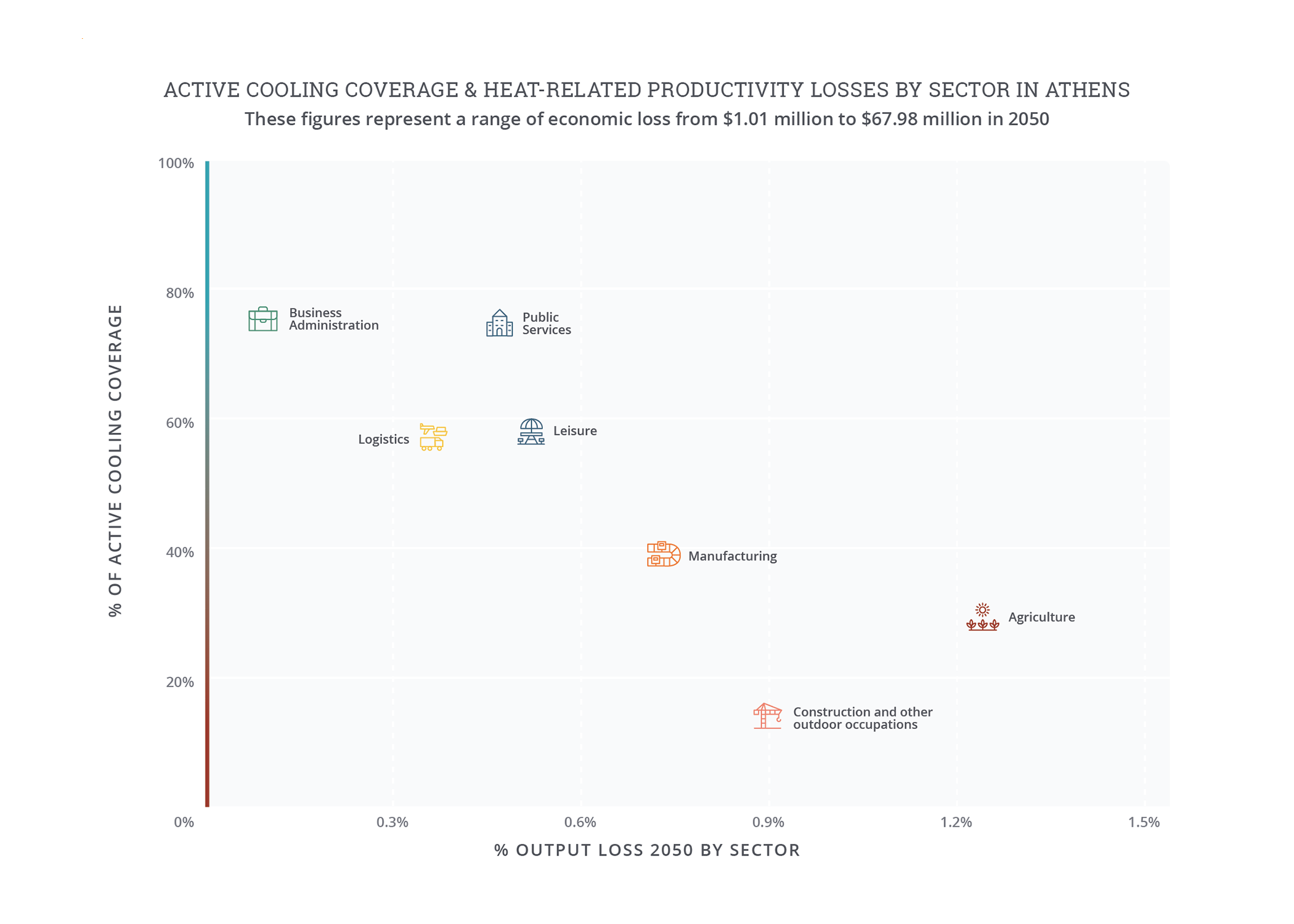Overview
Without action to reduce emissions, Athens’s hottest days are projected to become three times more frequent by 2050—from nine to ten days in a typical year today to twenty-seven by 2050.
Considering only Central Athens, heat-related output losses from labor productivity are projected to more than double from almost USD 100 million in a typical year today to USD 230 million (EUR 213.7 million) in 2050. These losses are likely to affect workers through reduced wages or income. Construction, manufacturing, and public-sector workers suffer outsize losses relative to the size of their sectors, due to a combination of lower levels of active cooling (AC) coverage and higher labor intensity.
The risk of local wildfires, already a serious local hazard, is exacerbated by and compounds the effects of heat waves, creating a dangerous feedback loop.
To protect its economy and its population, Athens can scale up a range of measures aimed at providing cooling facilities in its historic center, strengthening worker protection, and improving heat awareness among its most vulnerable residents.
Heat-related output losses from labor productivity are projected to increase from $100 million today to $230 million by 2050.
Impact of extreme heat
The climate of Athens1 is characterized by warm summers punctuated by extreme heat waves, and temperatures are rising. Already, the ten hottest days in Athens in a normal year have an average daily temperature (over twenty-four hours) of above 29.2°C, capturing both warmer evenings and daytime peak temperatures, with highs of 48°C recorded in recent years.2 Without global action to address climate change, the number of such extremely hot days is projected to triple to nearly thirty days every year by 2050. Athens’s Mediterranean climate, where hot summers follow cool winters, may make it more challenging for people to adapt to rapid changes in temperatures compared to people living in equatorial climates with warm weather year-round.3
Athens’s dense urban core allows relatively little space for parks or tree canopy cover to shade buildings and roads, raising temperatures in urban heat islands (UHI) throughout the city. Most of the population lives in the core of the city, which is dominated by built-up space that traps heat and leads to warmer temperatures than the surrounding countryside. The urban heat island hotspots in the center of the city are likely to intensify with climate change and to continue to spread out as the city develops further into the mountainous suburbs. Without action to limit emissions or adapt to the changing climate, by 2050 the hottest spots through Central Athens may reach temperatures as much as 15°C hotter than rural areas are today.4
Output losses due to heat-related worker productivity reductions in Central Athens alone are now valued at $98.4. This will rise to $230 million by 2050.
Output losses due to heat-related worker productivity reductions in Central Athens alone are valued at around almost USD 100 million (USD 98.4/EUR 91.4 million)5 in a typical year today to USD 230 million (EUR 213.7 million) by 2050.6 These losses are assessed over the four regional units of Central Athens, home to almost two-thirds of the population of 3.7 million in the wider metropolitan area, and do not include costs to health, infrastructure, and tourism demand, or indirect impacts to the broader economy. By 2050, without emissions reductions or further adaptation, losses from lost worker productivity due to extreme heat and humidity may amount to 0.3% of Athens’s projected 2050 output. More than half of the expected increase in output losses is due to increasing effects of climate change, and the remainder due to growth in economic output.7
Construction, manufacturing, and public-sector workers suffer outsize losses relative to the output of each sector, due to a combination of lower levels of AC coverage and higher labor intensity. Losses in logistics and public services each exceed USD 27 million (EUR 25.1 million), almost 30 percent of total losses in a typical year around 2020.8 This is due to the size of the logistics sector and its workers’ relatively high exposure to heat in occupations such as truck driving or warehousing; while workers in public-service roles such as teachers or police officers on average have better access to workplace active cooling, the greater reliance on human labor to generate output means that a smaller amount of heat stress has a greater impact. Highly vulnerable sectors such as construction and manufacturing face proportional losses twice as high as the logistics sector, but constitute a smaller share of the economy of Central Athens. A wider analysis of the Athens metropolitan area would include more of these vulnerable workers, resulting in higher percentage losses.



Note on “Projected number of hot and extremely hot days”: Days where the twenty-four hour average (i.e., daily) temperature exceeds the local 90th percentile of the baseline average daily temperature are defined as “hot days,” while days where the daily temperature exceeds the local 97.5th percentile are defined as “extreme hot days.” Because hot days are relative to typical local temperatures, the same daily temperature may be considered “hot” in one city but not another. The baseline is based on historical climate data, 1985-2005, while 2050 is based on the 2040-2060 climate projection from an ensemble of CMIP6 models under RCP 7.0.
Note on “Productivity losses by sector”:9 The agricultural sector captures loss within the defined city limits and does not account for agricultural loss from the surrounding rural areas. Baseline losses are based on historical climate data from 1985-2005 and economic data from 2019. 2050 losses are based on the 2040-2060 climate projection from an ensemble of CMIP6 models under RCP 7.0 and economic models under SSP3. Losses assume no change in sectoral composition of economy. Source: Vivid Economics.
Note on “Active cooling coverage and heat related productivity losses by sector”: O*NET, 2021; and analysis by Vivid Economics.
Extreme heat interventions
The city of Athens is leading efforts to reduce heat exposure and the vulnerability of its population. Continued efforts are required to tackle the rising temperatures across the city’s public and private spaces. Ongoing initiatives include:
- Planning/policy: While efforts to reduce temperature levels are being rolled out, Athens and its newly appointed Chief Heat Officer14 are taking further steps to protect people from the effects of extreme heat. During heat waves, worker protections take effect including longer breaks during peak heat hours and mandated air-conditioned rest areas with water provided.15
- Communications/outreach: Campaigns include urging vulnerable people to adopt coping mechanisms and to visit public cooling centers provided for their safety and well-being.16 During extreme heat waves, initiatives such as categorizing heat waves, which are being trialed in Athens and more broadly across Greece, can speed up emergency responses by signaling to government, employers, and individuals that heat resilience measures should be implemented.17
- Investment in the built environment and nature-based solutions: The city is renovating thirty-four of its historic water fountains in public squares to lower the temperature of the otherwise heat-catching spaces,18 and developing “pocket parks” to provide cooling green spaces dispersed throughout the densely built environment.19 Existing street trees, particularly Athens’s distinctive leafy mulberry trees, which have recently come under threat from wood-boring insects, must be protected to prevent new heat islands from emerging.20
Explore more city chapters
Return to the global summary
Endnotes
1 The economic impacts assessed here reflect the four regional units of Central Athens, North Athens, South Athens, and West Athens, and do not include productivity losses related to work within Piraeus or other parts of Attica. Some supporting research in this report goes beyond political boundaries to give a sense of how extreme heat and humidity impact Athens’ influence area.
2 All analysis is based on RCP 7.0 and SSP3 using an ensemble mean of CMIP6 models, and the accompanying methodology document provides details; and National Observatory of Athens, http://magazine.noa.gr/archives/4446.
3 For some discussion of the evidence, see e.g., Health Canada, “Adapting to Extreme Heat Events: Guidelines for Assessing Health Vulnerability,” 2011, https://www.canada.ca/en/health-canada/services/environmental-workplace-health/reports-publications/climate-change-health/adapting-extreme-heat-events-guidelines-assessing-health-vulnerability-health-canada-2011.html.
4 Analysis by Vivid Economics, based on summer average land surface temperature (LST), modeled climate data in 2050, and analysis of expected UHI and urban development by Kangning Huang et al., “Projecting Global Urban Land Expansion and Heat Island Intensification through 2050,” Environmental Research Letters 14, no. 11, 2019, https://iopscience.iop.org/article/10.1088/1748-9326/ab4b71.
5 Numbers are approximate and rounded to the nearest 10. Exchange rates from International Monetary Fund (2022). 2021 annual average exchange rate – 0.93 EUR/USD. Available at https://data.imf.org/regular.aspx?key=61545850.
6 Workability analysis is based on climate factors and not indoor working conditions determined by built environment characteristics or workplace layout (e.g., equipment that generates heat, body heat in close spaces, ventilation or greenhouse effects from windows, external shading). In practice, some of these factors can make indoor environments hotter than the modeled climate conditions suggest.
7 Economic growth is projected to be relatively modest for Athens under SSP3 assumptions; see methodology for further details.
8 Economic data in this report are from 2019 to avoid capturing the effect of COVID-19 on the economies of the cities analyzed; see methodology for further details.
9 The economic impacts assessed here reflect the four regional units of Central Athens, North Athens, South Athens, and West Athens, and do not include productivity losses related to work within Piraeus or other parts of Attica.
10 Aurora A. Gutierrez et al., “Wildfire Response to Changing Daily Temperature Extremes in California’s Sierra Nevada,” Science Advances 7, no. 47 (2021), https://www.science.org/doi/10.1126/sciadv.abe6417.
11 Chris Liakos et al., “Brutal Heat Wave Scorches Southern Europe as Continent’s Summer of Extreme Weather Rages On,” CNN, August 4, 2021, https://edition.cnn.com/2021/08/04/europe/southern-europe-extreme-weather-intl/index.html.
12 Harry Taylor, “Residents Evacuated as Wildfire on Outskirts of Athens Threatens Homes, Guardian, June 2, 2022, https://www.theguardian.com/world/2022/jun/04/wildfire-on-outskirts-of-athens-threatening-homes-and-infrastructure.
13 “Natural Disaster Alert: Increased Wildfire Danger in Greece,” US Embassy and Consulate in Greece (website), August 6, 2021, https://gr.usembassy.gov/natural-disaster-alert-increased-wildfire-danger-in-greece/.
14 Fiona Harvey, “Athens Appoints Chief Heat Officer to Combat Climate Crisis,” Guardian, July 23, 2021, https://www.theguardian.com/environment/2021/jul/23/athens-appoints-chief-heat-officer-combat-climate-crisis.
15 Derek Gatopoulos, “In Heat Emergency, Greece Adds Checks for Fires, Power Cuts,” AP via ABC News, July 30, 2021, https://abcnews.go.com/Technology/wireStory/heat-emergency-greece-adds-checks-fires-power-cuts-79166546.
16 Niki Kitsantonis, “Heat Emergency Brings Record Temperature and Fires to Southern Europe,” New York Times, August 3, 2021, https://www.nytimes.com/2021/08/03/world/europe/greece-turkey-heat-fires.html.
17 Helena Smith, “Greece Plans to Name Heatwaves in the Same Way as Storms,” Guardian, August 21, 2021, https://www.theguardian.com/world/2021/aug/21/greece-plans-to-name-heatwaves-in-the-same-way-as-storms.
18 “Athens Shines Spotlight on 34 Landmark Fountains,” Greek Travel Pages (webpage), February 5, 2021, https://news.gtp.gr/2021/02/05/athens-shines-spotlight-on-34-landmark-fountains/; and “Athens’ Flagship Fountains Get Facelift amid COVID-19,” Xinhua News, 2021, ;
19 “’Pocket Parks’ Are Helping Athens Tackle Pollution,” World Economic Forum, March 15, 2021, https://www.weforum.org/agenda/2021/03/athens-tackles-heat-pollution-parks-environment-greece/.
20 “Wood Borer Insect Threatens Athens’ Mulberry Trees, Says Municipality,” Kathimerini (online English edition), February 12, 2020, https://www.ekathimerini.com/news/249449/wood-borer-insect-threatens-athens-mulberry-trees-says-municipality/.
